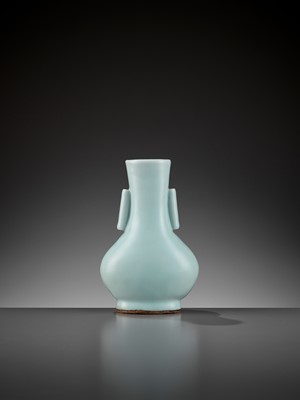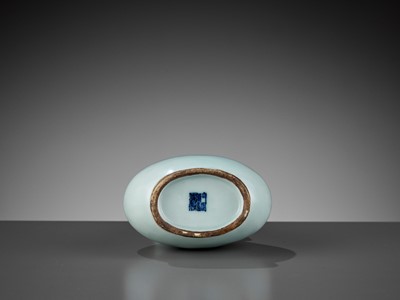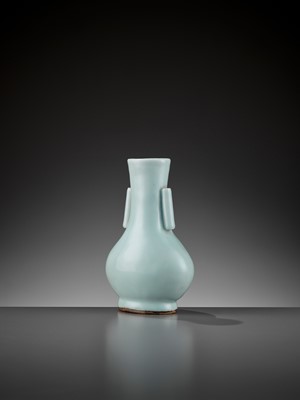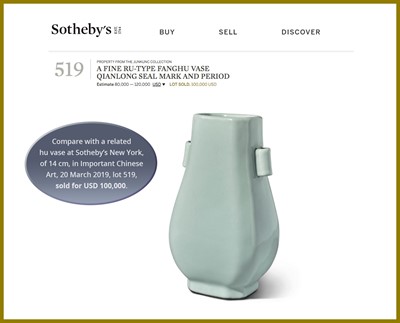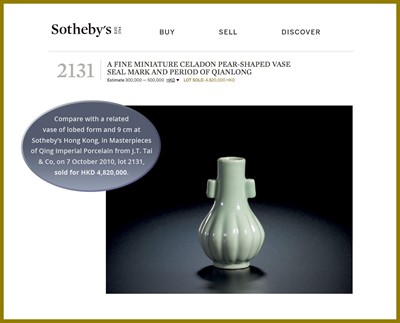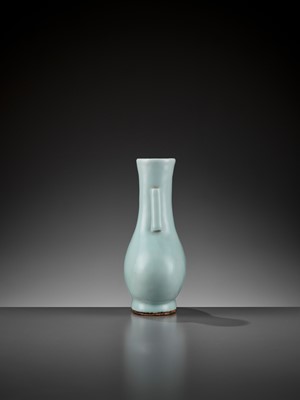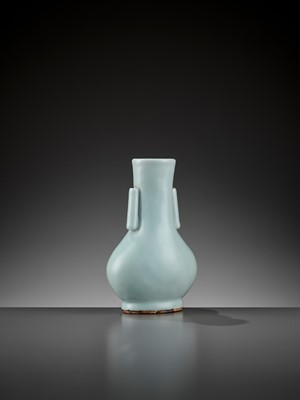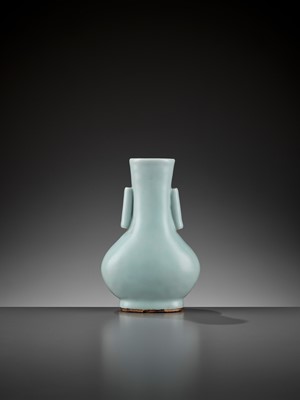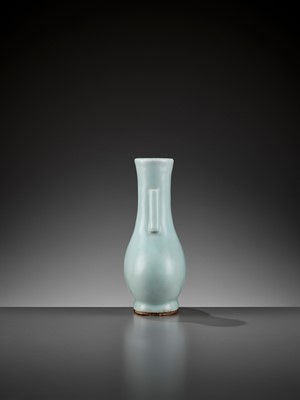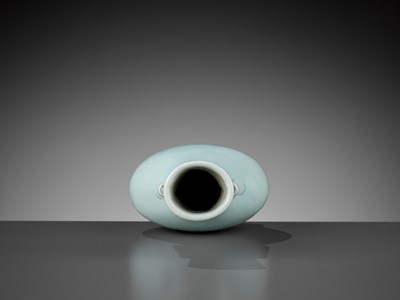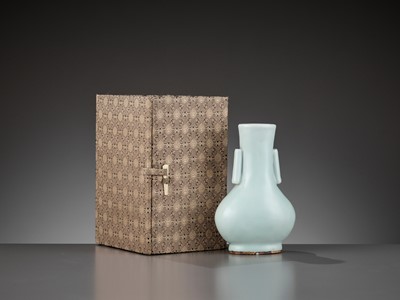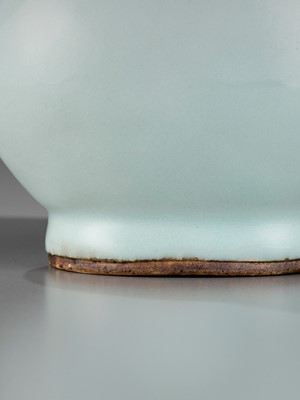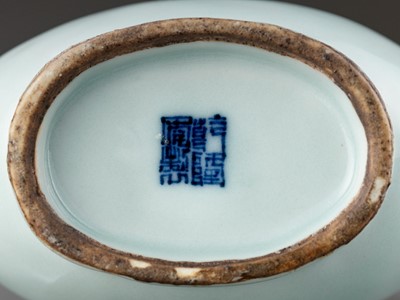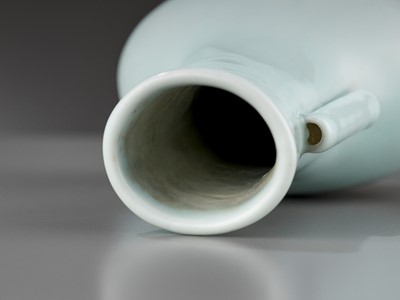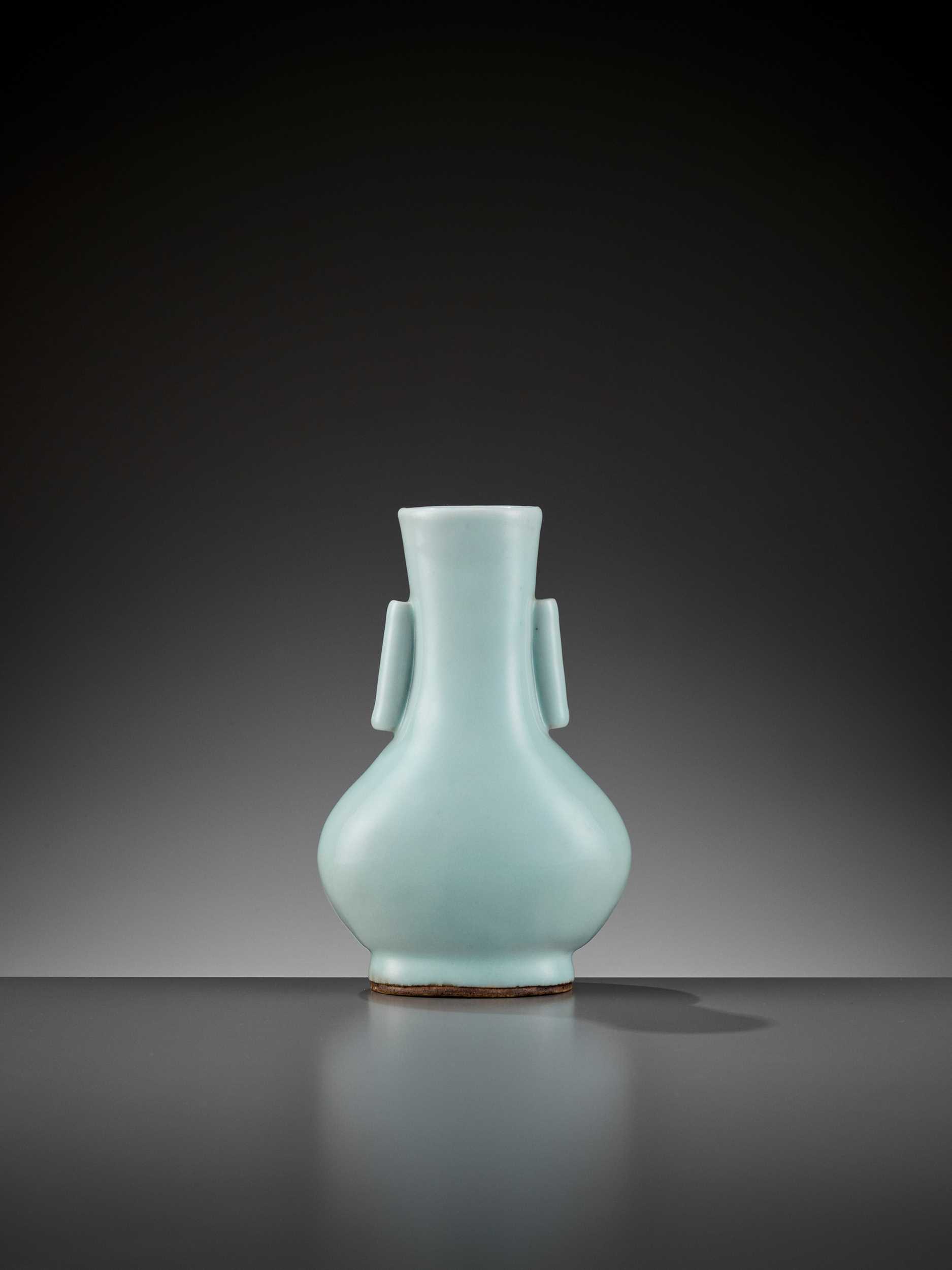5th Mar, 2021 10:00
TWO-DAY AUCTION - Fine Chinese Art / 中國藝術集珍 / Buddhism & Hinduism
243
AN EXTREMELY RARE ARCHAISTIC RU-TYPE ARROW VASE, TOUHU, QIANLONG MARK AND PERIOD
乾隆款及年代罕見仿汝釉貫耳投壺
Sold for €6,320
including Buyer's Premium
China, 1735-1796. Elegantly potted with a compressed globular body rising to a slightly waisted neck, flanked by a pair of tubular lug handles, covered overall in an unctuous and even Ru-type glaze, the recessed base similarly glazed and with a four-character Qianlong nianzhi seal mark in underglaze blue and of the period.
Provenance: From a European private collection and thence by descent in the same family.
Condition: Four tiny and shallow surface nibbles to the unglazed section of the foot rim, one with a microscopic touchup and the other three invisible from the outside. Otherwise in absolutely perfect condition (inspected under strong blue light).
Weight: 293.3 g
Dimensions: Height 15.1 cm
This charming and rare vase, of archaistic form, is made in imitation of the highly-treasured Ru ware of the Song dynasty. The Qianlong Emperor was declarative about his fondness of Imperial ceramic wares of this period (960-1279) going as far as to having many of the pieces in the Qing Court Collection inscribed with poems he had written extolling their virtues. During his reign, glazes imitating Jun, Ding, Guan, Ge and Ru wares, known as the five ‘official’ wares of the Song dynasty, were recreated in forms relating closely to their Song prototypes, such as the present example.
The high level of skill and keen attention to detail in simulating the distinctive characteristics of Song Imperial ware is evidenced in the soft, unctuous quality of the luminous glaze and at the foot which has been left unglazed and stained dark brown.
Furthermore, this vase is also a good example of the archaistic bronze forms produced during the Yongzheng and Qianlong periods. The interest in antiques during the Qing Dynasty concentrated on such archaic bronzes, which were copied by the imperial kilns at Jingdezhen, particularly since the Yongzheng period, and this interest continued under the Qianlong emperor.
Literature comparison: Compare a Qianlong Ru-type vase of related hu form in the Palace Museum, Beijing, illustrated in The Complete Collection of Treasures of the Palace Museum, Monochrome Porcelain, Hong Kong, 1999, pl. 216. There is also a related example in the National Palace Museum, Taipei, published in the Illustrated Catalogue of the Ch'ing Dynasty in the National Palace Museum, Ch'ien-lung Ware and Other Wares, Tokyo, 1981, pl. 82, and another included in John Ayers, The Baur Collection, Geneva, vol. III, Geneva, 1972, pl. 344.
Auction result comparison: Compare with a related vase of lobed form and 9 cm at Sotheby’s Hong Kong, in Masterpieces of Qing Imperial Porcelain from J.T. Tai & Co, on 7 October 2010, lot 2131, sold for HKD 4,820,000 and a related hu vase at Sotheby’s New York, of 14 cm, in Important Chinese Art, 20 March 2019, lot 519, sold for USD 100,000.
乾隆款及年代罕見仿汝釉貫耳投壺
中國,1735-1796年。直頸較長,腹部扁圓,圈足,頸部兩側對稱貼豎直的管狀貫耳。整體施仿汝釉,圈足内青花四字款“乾隆年制”。
來源:歐洲私人收藏,自此保存在同一家族至今。
品相:圈足未上釉部位四個小而淺的表面磕損,其中一個進行了小修,而另外三個則從外部看不到。除此之外絕對完美(在強烈的藍光下檢查)。
重量:293.3 克
尺寸:高15.1 厘米
拍賣結果比較:一件相近瓜棱形瓶見香港蘇富比 Masterpieces of Qing Imperial Porcelain from J.T. Tai & Co拍場,2010年10月 7日lot 2131, 售價HKD 4,820,000; 一件相近八方貫耳壺見紐約蘇富比,14厘米,Important Chinese Art拍場,2019年3月20日lot 519, 售價USD 100,000.
China, 1735-1796. Elegantly potted with a compressed globular body rising to a slightly waisted neck, flanked by a pair of tubular lug handles, covered overall in an unctuous and even Ru-type glaze, the recessed base similarly glazed and with a four-character Qianlong nianzhi seal mark in underglaze blue and of the period.
Provenance: From a European private collection and thence by descent in the same family.
Condition: Four tiny and shallow surface nibbles to the unglazed section of the foot rim, one with a microscopic touchup and the other three invisible from the outside. Otherwise in absolutely perfect condition (inspected under strong blue light).
Weight: 293.3 g
Dimensions: Height 15.1 cm
This charming and rare vase, of archaistic form, is made in imitation of the highly-treasured Ru ware of the Song dynasty. The Qianlong Emperor was declarative about his fondness of Imperial ceramic wares of this period (960-1279) going as far as to having many of the pieces in the Qing Court Collection inscribed with poems he had written extolling their virtues. During his reign, glazes imitating Jun, Ding, Guan, Ge and Ru wares, known as the five ‘official’ wares of the Song dynasty, were recreated in forms relating closely to their Song prototypes, such as the present example.
The high level of skill and keen attention to detail in simulating the distinctive characteristics of Song Imperial ware is evidenced in the soft, unctuous quality of the luminous glaze and at the foot which has been left unglazed and stained dark brown.
Furthermore, this vase is also a good example of the archaistic bronze forms produced during the Yongzheng and Qianlong periods. The interest in antiques during the Qing Dynasty concentrated on such archaic bronzes, which were copied by the imperial kilns at Jingdezhen, particularly since the Yongzheng period, and this interest continued under the Qianlong emperor.
Literature comparison: Compare a Qianlong Ru-type vase of related hu form in the Palace Museum, Beijing, illustrated in The Complete Collection of Treasures of the Palace Museum, Monochrome Porcelain, Hong Kong, 1999, pl. 216. There is also a related example in the National Palace Museum, Taipei, published in the Illustrated Catalogue of the Ch'ing Dynasty in the National Palace Museum, Ch'ien-lung Ware and Other Wares, Tokyo, 1981, pl. 82, and another included in John Ayers, The Baur Collection, Geneva, vol. III, Geneva, 1972, pl. 344.
Auction result comparison: Compare with a related vase of lobed form and 9 cm at Sotheby’s Hong Kong, in Masterpieces of Qing Imperial Porcelain from J.T. Tai & Co, on 7 October 2010, lot 2131, sold for HKD 4,820,000 and a related hu vase at Sotheby’s New York, of 14 cm, in Important Chinese Art, 20 March 2019, lot 519, sold for USD 100,000.
乾隆款及年代罕見仿汝釉貫耳投壺
中國,1735-1796年。直頸較長,腹部扁圓,圈足,頸部兩側對稱貼豎直的管狀貫耳。整體施仿汝釉,圈足内青花四字款“乾隆年制”。
來源:歐洲私人收藏,自此保存在同一家族至今。
品相:圈足未上釉部位四個小而淺的表面磕損,其中一個進行了小修,而另外三個則從外部看不到。除此之外絕對完美(在強烈的藍光下檢查)。
重量:293.3 克
尺寸:高15.1 厘米
拍賣結果比較:一件相近瓜棱形瓶見香港蘇富比 Masterpieces of Qing Imperial Porcelain from J.T. Tai & Co拍場,2010年10月 7日lot 2131, 售價HKD 4,820,000; 一件相近八方貫耳壺見紐約蘇富比,14厘米,Important Chinese Art拍場,2019年3月20日lot 519, 售價USD 100,000.
Zacke Live Online Bidding
Our online bidding platform makes it easier than ever to bid in our auctions! When you bid through our website, you can take advantage of our premium buyer's terms without incurring any additional online bidding surcharges.
To bid live online, you'll need to create an online account. Once your account is created and your identity is verified, you can register to bid in an auction up to 12 hours before the auction begins.
Intended Spend and Bid Limits
When you register to bid in an online auction, you will need to share your intended maximum spending budget for the auction. We will then review your intended spend and set a bid limit for you. Once you have pre-registered for a live online auction, you can see your intended spend and bid limit by going to 'Account Settings' and clicking on 'Live Bidding Registrations'.
Your bid limit will be the maximum amount you can bid during the auction. Your bid limit is for the hammer price and is not affected by the buyer’s premium and VAT. For example, if you have a bid limit of €1,000 and place two winning bids for €300 and €200, then you will only be able to bid €500 for the rest of the auction. If you try to place a bid that is higher than €500, you will not be able to do so.
Online Absentee and Telephone Bids
You can now leave absentee and telephone bids on our website!
Absentee Bidding
Once you've created an account and your identity is verified, you can leave your absentee bid directly on the lot page. We will contact you when your bids have been confirmed.
Telephone Bidding
Once you've created an account and your identity is verified, you can leave telephone bids online. We will contact you when your bids have been confirmed.
Classic Absentee and Telephone Bidding Form
You can still submit absentee and telephone bids by email or fax if you prefer. Simply fill out the Absentee Bidding/Telephone bidding form and return it to us by email at office@zacke.at or by fax at +43 (1) 532 04 52 20. You can download the PDF from our Upcoming Auctions page.
How-To Guides
How to Create Your Personal Zacke Account
How to Register to Bid on Zacke Live
How to Leave Absentee Bids Online
How to Leave Telephone Bids Online
中文版本的操作指南
创建新账号
注册Zacke Live在线直播竞拍(免平台费)
缺席投标和电话投标
Third-Party Bidding
We partner with best-in-class third-party partners to make it easy for you to bid online in the channel of your choice. Please note that if you bid with one of our third-party online partners, then there will be a live bidding surcharge on top of your final purchase price. You can find all of our fees here. Here's a full list of our third-party partners:
- 51 Bid Live
- EpaiLive
- ArtFoxLive
- Invaluable
- LiveAuctioneers
- the-saleroom
- lot-tissimo
- Drouot
Please note that we place different auctions on different platforms. For example, in general, we only place Chinese art auctions on 51 Bid Live.
Bidding in Person
You must register to bid in person and will be assigned a paddle at the auction. Please contact us at office@zacke.at or +43 (1) 532 04 52 for the latest local health and safety guidelines.
